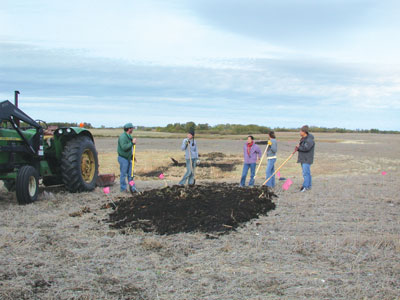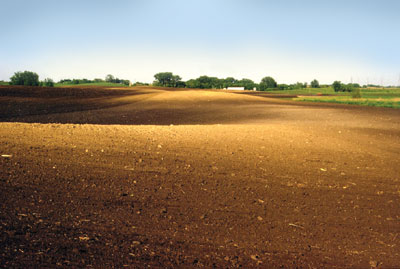
Features
Agronomy
Tillage
Restored hilltops give payback
A grower who has taken a week in the fall to shift topsoil from the bottom of a hill or a drainage ditch back up to the top should give him or herself a pat on the back. It is a good thing, and probably will quickly repay the effort, according to Dr. David Lobb, University of Manitoba soil scientist, based in Winnipeg.
May 25, 2010 By John Dietz
A grower who has taken a week in the fall to shift topsoil from the bottom of a hill or a drainage ditch back up to the top should give him or herself a pat on the back. It is a good thing, and probably will quickly repay the effort, according to Dr. David Lobb, University of Manitoba soil scientist, based in Winnipeg.

|
| Research has found that restoring eroded areas has a payback in as little as three years. (Photo courtesy of David Lobb, University of Manitoba)
|
For 20 years, Lobb has investigated causes of soil variability in field landscapes and looked for possible cures. His work began at the University of Guelph in 1987. For most of the 1990s, he was in the heart of Atlantic Canada’s potato country, at the University of Moncton. He came to Manitoba in 1999.
Wind, rain and melting snow do have a role in erosion, Lobb says, but the primary cause of “lost” soil on hilltops and for soil-filled drainage ditches is cultivation. It could be from a moldboard plow, but it also could be happening on a zero-till farm with high-disturbance seeding equipment.

|
|
| Knolls are primarily eroded by high-disturbance tillage. (Photo courtesy of David Lobb, University of Manitoba) |
Tillage erosion
Soil that is disturbed, for whatever reason, tends to move downslope. He calls it tillage erosion. “Wind and water erosion actually degrade the soil structure. In comparison, tillage erosion simply moves soil downhill like a conveyor belt. You really don’t lose much in terms of quality; it just shifts down slope and tends to keep the original properties,” he explains.
An eroded knoll often looks pale. Crops struggle, thin out and fail at the crest. At the bottom of the slope, yields may be high. Below the surface soil in this area, Lobb has learned, it is not unusual to find 50 or even 100 centimetres (up to 20 inches) of topsoil.
Tillage erosion is not confined to the obvious hills and hummocks, he adds. “Many farms have flat areas that need surface drains. Some have wetlands they try to surface drain. Tillage erosion fills in these small areas as fast as the big, steep slopes. It happens on every piece of land you till. The biggest cause of filling surface drains in the Red River Valley is not water erosion; it’s tillage. They fill them in with every tillage operation.”
A one-pass seeding operation and fall harrowing may, or may not, eliminate tillage erosion. “Some zero-till is low disturbance, and some zero-till is high disturbance,” Lobb says. “When we’ve compared different levels of soil movement by seeding operation, we’ve seen high disturbance seeders cause as much tillage erosion as a moldboard plow. ”High disturbance seeders don’t move a lot of soil, but they move it very far, and they move it with a lot of variability, which causes the erosion. If you do high disturbance seeding, you probably still remove enough topsoil to never recover the productivity on an eroded hilltop, even if you’re in zero-till for 20 years.”
Scrape and replace
Lobb now has four research sites in Manitoba and is involved with related studies in Minnesota and South Dakota.
“We found that, in areas where soil had accumulated, only the top six to 10 inches is biologically active. That’s where fertilizer is applied, where roots are growing, where the microbes are thriving.”
In principle, he has learned the best “solution” is to scrape off the accumulated soil at the bottom of a slope or ditch and put it back where it came from.
Southern Manitoba is very unusual in that many farms have a small scraper. Normally the scraper is used for field drainage. With good weather in the fall, and patience, many farms could use that scraper to restore the landscape, put topsoil back in place and improve yields on the knolls or hummocks.
Lobb’s colleagues in ag economics have done the analysis on payback, assuming the grower paid a commercial rate for moving topsoil back up-slope. “With all of those costs in doing a commercial operation, we feel now that the result would pay for itself in three to five years,” he says. “As a land improvement practice, this is actually more lucrative than irrigation or drainage, where the payback period may be five to 10 years. This practice may bump your yield by 50 percent to 100 percent on maybe a quarter of your field area, and increase the field average by 10 to 20 percent. That’s a significant improvement.”
At one site, researchers excavated 20 to 25 centimetres (eight to 10 inches) of topsoil in a single season and moved it to the hilltop. Later, crop seeded into the remaining topsoil at the bottom of the slope struggled; yield was disappointing. “It makes sense,” he says. “If you scoop or scrape away everything that makes the soil healthy and put it on the hilltop, it’s going to take a while for that formerly buried topsoil at the base to recover. But, you may be able to remove five to 10 centimetres (two to four inches) from the lower slope position in a given year and not suffer a yield loss. There’s a bit of a balance, between how much you want to remove from the base and how much you want to add to the top.”
Two caveats
The scrape-and-replace remedy has at least two caveats, Lobb says. The first is about time. This is work for the fall, after all other field operations. It may require one or two weeks of good open weather, as well as fuel, to move a significant amount of topsoil. This could be a regular farm task for many years on a large farm.
The second is about soil management. “That soil will only stay up there as long as you don’t till. You have to go to some form of reduced till or no-till if you do restore the hilltop. Otherwise, you’re back on the same path if you go in with conventional tillage or with any high-disturbance equipment.”
Best management practices for reducing tillage erosion are available, Lobb says. He promotes tillage tools that do minimum disturbance and travel at speeds to minimize soil movement and its variability. Good tools include the Barton single-disk soil openers and narrow knives. Speed can be kept fairly constant by not exceeding manufacturer’s recommended speed and having the draft requirement of the implement properly matched to the power of the tractor.
Smooth and ripple coulters are better options than a wavy coulter.
Contour tillage may help reduce the tillage erosion process if a moderate constant speed is maintained.
Terrace-type efforts, on the other hand, will increase tillage erosion. “Every time you put a break in the field slope, you increase tillage erosion. If you put three breaks into a nice long slope, you may decrease water erosion by half but you quadruple the tillage erosion. You now have four areas on that original slope that have the same level of tillage erosion,” Lobb says.
The soil management guide for Manitoba has some recommended practices, he adds, including information on restoring hilltops.